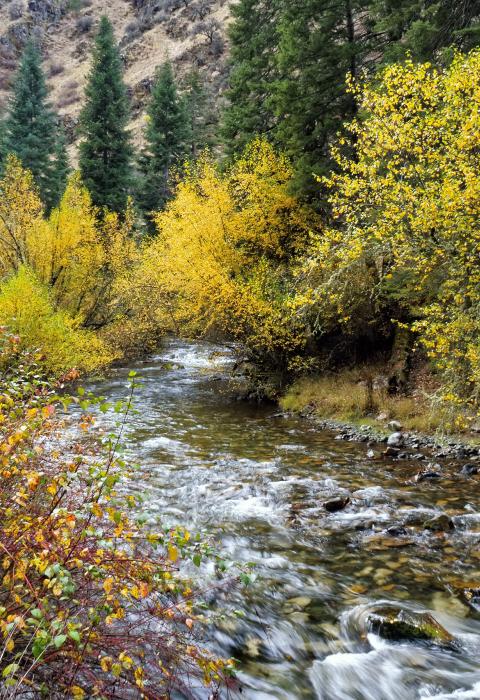Rapid River
Idaho
Rapid River is located on the Payette and Nez Perce National Forests; Riggins, Idaho is the closest town. The designated river is a part of the Hells Canyon National Recreation Area, although it extends eastward from the core of the HCNRA. The Rapid River is also within a roadless area, approximately 80% of which is managed to maintain its undeveloped character. The mainstem is a tributary to the Little Salmon River, entering the river approximately four miles from the confluence of the Little Salmon with the Salmon River. The Rapid River Fish Hatchery is located on the Rapid River and was built to mitigate lost runs of chinook salmon caused by the construction and operation of the Hells Canyon Dam.
The water quality of Rapid River is exceptional; the river supports three listed fish species—chinook salmon, steelhead, and bull trout—and associated critical habitat.
The river’s scenery is also outstanding; the steep gradient and narrow canyon focus the viewer's perspective on the fast-moving water and diverse riparian vegetation.
Designated Reach
December 31, 1975. The segment from the headwaters of the main stem to the national forest boundary. The segment of the West Fork from the wilderness boundary downstream to the confluence with the main stem.
Outstandingly Remarkable Values
Culture
The Rapid River corridor is within the Nez Perce Tribe Treaty of 1855 ceded land. The Treaty of 1855 provided, in part, for “The exclusive right of taking fish in all the streams where running through or bordering said reservation is further secured to said Indians, as also the right of taking fish at all usual and accustomed places.”
There continues to be a strong connection between tribal members, the Rapid River, and the associated salmon fishery. Several Nez Perce tribal members recount powerful stories of their first experience dip netting for salmon on the Rapid River. The stories associated with the Rapid River and the traditional fishing practices reveal the importance of the culture and tradition passed down in tribal families to protect the right to fish at “usual and accustomed places” as afforded by off-reservation rights.
To date, one prehistoric site, a trail that may be prehistoric, and a historic site with a prehistoric component have been recorded within the Rapid River corridor. Additionally, other prehistoric sites may exist within the corridor based on evidence of rock shelters, pictographs, and cupuled rocks recently recorded at the confluence of the Rapid River and Little Salmon River. This will not be known until further surveys have been accomplished. The prehistoric site is an extensive lithic scatter. The dual component site contains culturally peeled trees. The prehistoric site is eligible for the National Register of Historic Places.
Fish
Rapid River contains three listed fish species (spring/summer chinook salmon, steelhead, and bull trout) and designated critical habitat for chinook and steelhead. The river also contains the Columbia spotted frog, a sensitive species. In terms of habitat, the Rapid River watershed is the largest and best remaining aquatic stronghold within the Little Salmon River system. It is a key area for the survival and recovery of listed salmon, steelhead, and bull trout.
History
Twelve historic sites have been recorded within the Rapid River corridor. Seven of these sites are eligible or potentially eligible for the National Register of Historic Places. These sites include three homestead and/or mining cabins, a historic Forest Service Administrative site with two cabins, a trail, and two stock driveways. Five sites, which have been unofficially determined ineligible for National Register of Historic Places by the Forest Service, but are interesting nonetheless, include two cabin ruins, two mining sites, and a grave. Examined as a whole, along with the eligible sites, these potentially ineligible sites may provide information that is important to history or prehistory and therefore may actually be significant. Although not meeting National Register criteria, the grave must be protected under other laws and can provide information important to regional history. Additional historic sites may exist within the corridor; however, this will not be known until further surveys have been accomplished. The archaeological and historical research potential of the river corridor is unlimited.
Scenery
The riverine setting is generally natural in appearance with human activity, such as grazing, mining, and recreation use, having relatively little impact to scenic character. The lower four miles of the mainstem are the most scenically diverse, with views of the canyon’s interesting rock outcrops and the river’s pools, cascades, and clear water. The riverside trails provide an occasional distant view of the craggy peaks in the Seven Devils; however, the foreground view is generally limited to the immediate riparian zone due to the narrowness of the canyon and its steep walls. The user’s focus is on the river, its fast-moving water, and diverse riparian vegetation.
The river’s steep gradient also contributes to diversity of interaction of water and watercourse. Many portions of the Rapid River flow through pools and cascade/riffle complexes that draw the observer’s focus to the river. Although most of these complexes are small, a falls/cascade complex about 500 feet high is located approximately one-quarter mile up West Fork Rapid River.
Water Quality
Relative to other streams in the area, the Rapid River has high summer and fall flows. This translates into lower summer water temperatures than are typical for a river at this elevation. Lower water temperatures are also a result of the confined canyon/shading provided by the canyon walls; high quality riparian condition; and the narrow channel. Temperatures are well within the limits expected for a natural stream and closer to the optimum for salmonid spawning and rearing than other local streams. Sediment yield and suspended sediment concentration in the Rapid River are low during most of the year.

